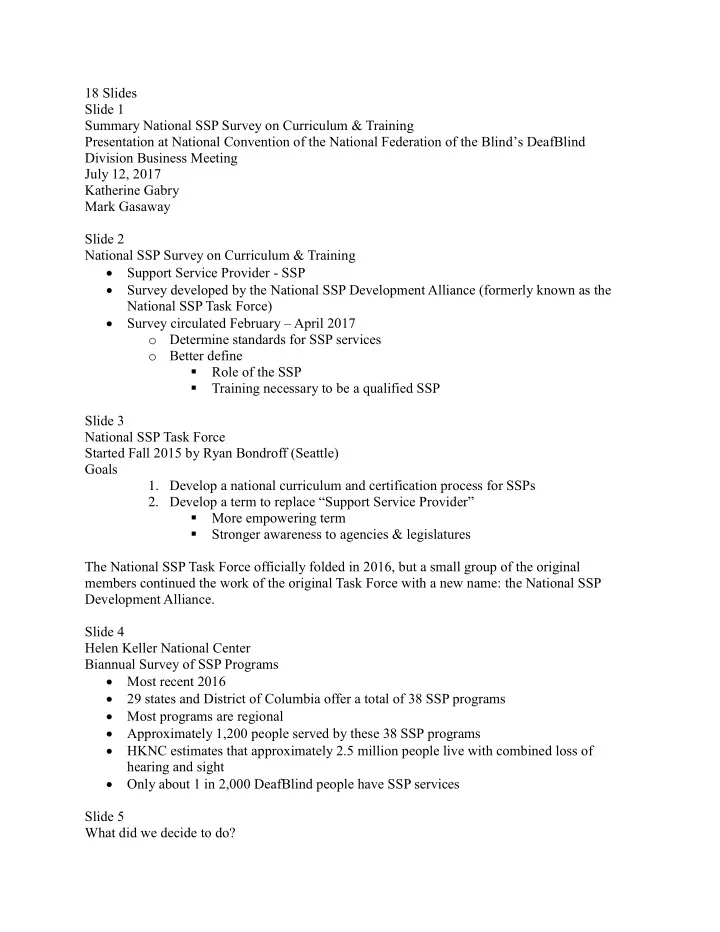

18 Slides Slide 1 Summary National SSP Survey on Curriculum & Training Presentation at National Convention of the National Federation of the Blind’s DeafBlind Division Business Meeting July 12, 2017 Katherine Gabry Mark Gasaway Slide 2 National SSP Survey on Curriculum & Training Support Service Provider - SSP Survey developed by the National SSP Development Alliance (formerly known as the National SSP Task Force) Survey circulated February – April 2017 o Determine standards for SSP services o Better define Role of the SSP Training necessary to be a qualified SSP Slide 3 National SSP Task Force Started Fall 2015 by Ryan Bondroff (Seattle) Goals 1. Develop a national curriculum and certification process for SSPs 2. Develop a term to replace “Support Service Provider” More empowering term Stronger awareness to agencies & legislatures The National SSP Task Force officially folded in 2016, but a small group of the original members continued the work of the original Task Force with a new name: the National SSP Development Alliance. Slide 4 Helen Keller National Center Biannual Survey of SSP Programs Most recent 2016 29 states and District of Columbia offer a total of 38 SSP programs Most programs are regional Approximately 1,200 people served by these 38 SSP programs HKNC estimates that approximately 2.5 million people live with combined loss of hearing and sight Only about 1 in 2,000 DeafBlind people have SSP services Slide 5 What did we decide to do?
Survey experienced SSPs! We defined “experienced SSP” as one who has: 1. Worked at least 15 volunteer and/or paid assignments 2. Worked with at least 5 different people 3. Used a variety of language, mobility and communication skills Slide 6 Development of the Survey 9 month process Established a team of 13 Peer Reviewers 1. DeafBlind individuals 2. SSPs 3. Interpreters 4. Family members Team provided review, creative problem solving, writing, critique, kudos, testing … not once, not twice, but three times! Distribution 1. DeafBlind people, camps, organizations, SSP programs 2. Family, friends 3. Email, social media Slide 7 Survey Content Demographics The work of SSPs How SSPs are trained Core Concepts SSPs believe are necessary Challenges on the job 274 SSPs took the survey. Slide 8 Demographics of SSPs Who Took Survey Women = 73% Men = 26% Older than 30 = 87% Younger than 30 = 12% Older than 45 = 60% Hearing and sighted = 55% Deaf or Hard of Hearing = 43% DeafBlind = 2% Blind = 0% Slide 9 Longevity of Experience indicates a longtime commitment to the community 43% more than 10 years
20% more than 5 years 83% report a personal relationship/friendship with someone who is DeafBlind Slide 10 Languages Used American Sign Language = 94% Tactile American Sign Language = 85% Spoken English = 63% Touch communication systems = 56% Slide 11 States with the Highest SSP Survey Response Washington State = 20% New Jersey = 12% New York, Maryland, Ohio = 10% each Pockets of SSP Services Seattle New York – New Jersey metropolitan area Washington, DC metropolitan area Ohio Smaller pockets in Florida, California, Minnesota Slide 12 Typical SSP Activities Shopping Errands Travel Workshops/trainings Conferences Medical appointments Social activities Clubs/organizations Slide 13 SSP Training More than 70% of the SSPs said they learned their skills in a variety of ways: from DeafBlind people, from multiple SSP training workshops and programs, and on their own. All of them – every one – felt that DeafBlind people should be involved in the training. The average ranking the SSPs gave their formal training program was 8 out of 10. Slide 14 Core Concepts Surveyed Introduction to DeafBlind Role of the SSP Providing Visual & Environmental Information Communication
Practicing Skills Mobility & Safe Travel DeafBlind Culture SSP Environments The Professional SSP Slide 15 Where SSPs Wanted More Training All forms of communication & communication styles, including specifically touch communications (ProTactile, Haptics) Real-life practice O&M Dealing with challenging situations Spending more time with DB mentors Setting boundaries Taking care of themselves Slide 16 SSP Comments on Their Work Making a positive difference Providing access that leads to inclusion in the greater community Exposure to a rich culture Making great lifelong friends Knowing that because they offered their time, another person can exercise their rights as an independent, self-empowered individual Slide 17 Are SSPs interested in a national certification? 90% said YES Slide 18 Next Steps Finish compiling the survey data Crosstrain interpreters and interveners as SSPs Survey DeafBlind people 1. Role of the SSP 2. Expectations of SSP services 3. Training SSPs Build the National SSP Database To use the database, email: NSSPCert@gmail.com
Recommend
More recommend